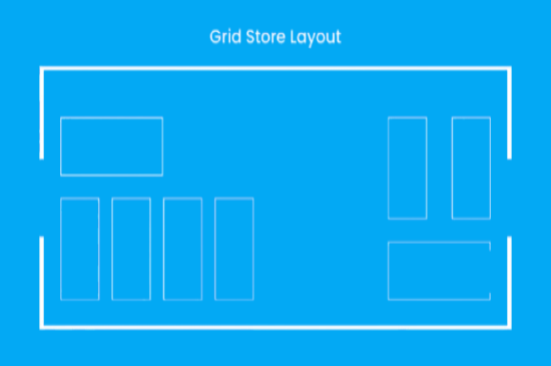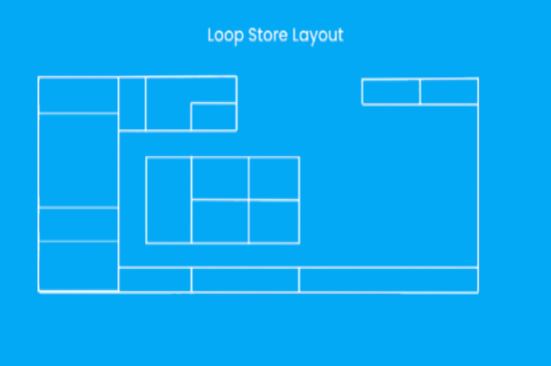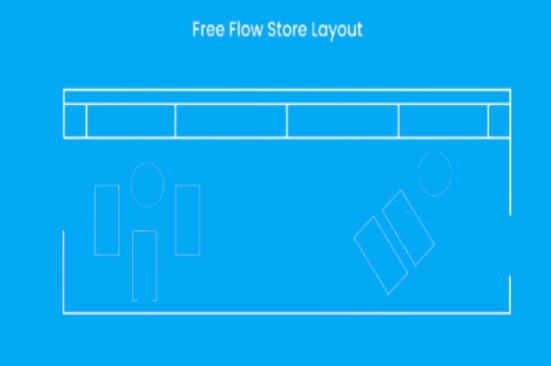Supermarket / Grocery Store Layout
The Strategic Significance of Supermarket or Grocery Store Layout
The performance and prosperity of a supermarket or grocery business are significantly influenced by layout planning and design. Planning a layout can increase foot traffic, sales, and customer satisfaction. First of all, buyers may more easily find their products in stores with a well-designed layout. In addition, it promotes items that might not have been on clients’ shopping lists. A badly planned layout has negative effects. It can, among other things, make customers’ purchasing experiences frustrating. This will undoubtedly have a negative impact on efforts to retain customers. Consequently, grocery stores and supermarkets require significant layout design planning and thought. Let’s examine the strategic importance of grocery shop or supermarket layout.
Focal Point & Visual Merchandising
This will undoubtedly have a negative impact on efforts to retain customers. Consequently, grocery stores and supermarkets require significant layout design planning and thought. Let’s examine the strategic importance of grocery shop or supermarket layout.distinct area with ornamental elements, unique lighting, and signs informing them about new deals or services.
Display Strategy: Eye Level/ FIFO Display
FIFO-based displays and maintaining items at eye level are two crucial aspects of a merchandising display approach.
The goal of eye-level displays is to make sure that the products are arranged on the shelves so that they are at eye level with the consumers or other bystanders. In addition to being convenient for customers, eye-level displays assist retail establishments in emphasizing priority items. Products that are positioned in this manner typically sell better than ones that are not at eye level.
In contrast, products in FIFO displays are arranged so that the oldest things are consumed or sold first. This reduces the possibility of waste or spoiling and guarantees that items are constantly fresh. FIFO displays are particularly crucial.for perishable goods like vegetables, meat, and dairy.
In-Store Technology
Any technological solution or application used in retail establishments for improved management and/or consumer convenience throughout the shopping process is referred to as “n-store technologies.” Supermarket and grocery shop design layouts are increasingly relying on in-store technology solutions. The fact that it alters how retailers can use the available space is one of the strategic justifications for this. These are a few well-known instances of in-store technology that is frequently seen at grocery stores and supermarkets.
Customers don’t have to wait in lines to check out while using self-checkout devices. They only need to pay their payments and scan the items they have chosen. With the exception of ad hoc or emergency scenarios, retailers gain from not having to depute cashiers.
Smart carts, sometimes known as an enhanced version of the self-checkout mechanism, are a step forward of self-checkout systems. Customers’ items in shopping carts are automatically scanned by this technology, and bills are generated appropriately. Through digital interaction with the smart carts, customers may make payments.
Retailers can show real-time product, price, promotion, offer, and other information from a single central location by using electronic shelf labels. This procedure does not require human mediation or involvement. With the necessary consents from clients, the same thing might be accomplished through notifications and shopping apps on smartphones.
The deployment of AI-enabled cameras in retail establishments is a relatively new trend. These are employed to monitor on stock levels, examine foot traffic during peak hours to make any required space modifications, etc. When utilizing cameras in their establishments, retailers should give careful thought to and adhere to the relevant regulations.
Lighting and Music
We are all aware of how important music and lighting are to our moods. Soft music and bright lighting are two frequent features found in practically every supermarket or retail store. For visibility, bright illumination is essential. A retail establishment is not a café or restaurant where the atmosphere could be enhanced by using partial darkness or dim lighting. Transparency is also indicated by lighting. Although it may not be required, music has the potential to enhance the magic when performed well. Avoid loud decibels at all costs. When choosing music or songs, retailers should also take sentiments and sensitivity into consideration.
Type of Layouts and its Ramifications
Supermarkets, department stores, and grocery stores all have standard layouts. These kinds are found all throughout the world and are universal. Next, a few of the most common layout types are briefly discussed.
- Grid Layout: As the name suggests, the shelves in this supermarket aisle arrangement are arranged in a grid pattern. It is straightforward and uncluttered. It provides plenty of room for space optimization and facilitates simple navigation.

- Loop or Racetrack Layout: In a racetrack layout, the store’s perimeter serves as the main and sole conduit and flow for traffic. Throughout the entire in-perimeter aisle, the shelves stay in the middle. For stores that are comparatively smaller, this is a decent choice.

- Free-Flow Layout: For retail establishments looking to provide their patrons with a more captivating and visually stimulating shopping experience, free-flow design is perfect. It depicts an open supermarket floor design with additional dimensions and product placements and displays. Customers can navigate the store in certain ways because to the design’s straightforward layout.

- Fixed Path Layout or Forced-Path Layout: These layouts use a predetermined arrangement for the aisles and shelves. The store is covered by a certain path, way, or flow, and the traffic flow is linear. The checkout action or counter is the final checkpoint.

- Hybrid Layout: This type of layout combines two or more different styles. It provides the freedom to design a layout that meets specific marketing, business, or customer experience goals.
Data-driven Planogram
Data analytics is used to determine product placements in data-driven planogram planning. This information may relate to the most-visited shelves and shelf levels, sales information, traffic patterns, etc. The goal is to enhance sales by positioning products so that clients can easily see and select them.
How TRS Can Help in Retail Layout Planning and Designing
1. Supermarket Functional Layout Design & Conceptualization
Hundreds of aspects must be taken into account while creating a supermarket layout plan. Space optimization, visual merchandising, the ability to display the necessary inventory, focal points, promotion, memory hooks, inventory flow, employee and customer convenience, customer mobility, ease of cleaning, special precautions, emergency response, safety and security, etc. are some of these factors.
The professionals at TRS who specialize in supermarket layout design are aware of how important it is to take into account all pertinent elements when creating a practical and effective floor plan and layout. All things considered, TRS pays close attention to these important elements in an attempt to guarantee that the layout solutions it provides to its clients satisfy the highest standards and specifications for functionality and space optimization.
2. Grocery Shop Layout Strategy and Interior Design
A grocery store or kirana store layout, like that of a supermarket, requires a well-defined plan that considers a number of factors, including merchandising capabilities, visual merchandising, serving requirements, staff and inventory movement, customer convenience, minimizing the extent of damage and theft, focal points, store facade, visibility, ease of cleanliness, safety and security, etc.
Securing operational efficiency, improving the quality of the consumer experience and their shopping journeys, and creating room for handling higher company volumes are TRS’s top priorities when creating grocery store map layouts and layout designs.
Following the development of a practical plan, attention is turned to creating an aesthetically pleasing store.
The interior design specialists of TRS work on the following projects:
- Layout of furniture and fixtures,
- HVAC,
- plumbing,
- electrical, and civil layouts,
- as well as 3D designs
3. Tech-Enabled Store Design Consulting
Apart from offering store design and planning services, TRS’s team of experts assesses and chooses the technologies that are best suited for its retail clients. The team helps incorporate these technological solutions into the business’s operations. TRS also assists in identifying and selecting vendors to complete these initiatives.
Some popular in-store tech choices (some have already been discussed) include:
- Systems for Self-Checkout
- Intelligent Baskets and Carts
- Labels for Electronic Shelves
- Screens for Display
- Beacons (new)
- Systems that are Omnichannel
- Applications for Smartphones
- AI-driven remedies
About TRS
With over a decade of experience, Your Retail Coach (TRS) is a retail and eCommerce consulting company with an expanding global footprint. In more than 25 verticals, we have collaborated with and provided business solutions to more than 500 clients.
The team of skilled and knowledgeable supermarket and grocery consultants at TRS has worked on a number of projects, providing expert and top-notch retail layout design services and solutions.
Please leave a message on our website if you have any questions about our services or would want to speak with one of our professionals briefly.
For service-related enquiries or a quick conversation with one of our experts, please drop us a message on our website.
FAQs
How to start a retail business? How do you start a retail business?
TRS franchise consultants developed the following eight steps for franchising a business:
1. Development of Franchise Strategies.
2.Development of Franchise Models (Foco, Cofo, Fofo, custom-built, etc.).
3.Manual of Franchise Operations.
4.Draft of a Franchise Agreement.
5.Manual for Franchise Setup.
6.Pitch deck and proposal for a franchise business.
7.Strategy for Generating Franchise Leads.
8.Report on Franchise Audits.
9.Speak with TRS franchise specialists to learn “how to set up a franchise business?” Click Here
How to manage retail stores successfully?
Both the franchisor (also known as the franchise operator) and the franchisee are necessary for any franchise model to function. Determining the roles of a franchise operator and a franchisee is crucial while operating in a franchise mode. The roles of these two parties vary based on two key aspects, such as “who will invest how much?” and “who will operate the franchise store?” in different types of franchise models.
For instance, in the FOCO model, the company will run and the franchise will invest. This is a common restaurant franchise model used by companies such as KFC. The FOFO model, which is typically offered by smaller firms that lack the bandwidth to run enterprises, requires franchisees to both invest and run their franchise stores.
The model, which will be described in a franchise business model template, will be defined by qualified franchise consultants. In the event that the brand has engaged one of the top franchise consulting firms, they will do a thorough brand assessment and develop a “best-fit hybrid franchise business model.”
Speak with YRC franchise specialists to learn more about “how does franchise model work?” Click Here
How to manage inventory in retail?
The franchise business plan is one of the most important things to create during the franchise development process. The components of a franchise business plan include:
1.Five-year sales and operations plan
2.Five-year financial plan
CAPEX & OPEX,
3.franchise breakeven period
4.Franchise ROI and ROC
5.Financial ramifications of the franchise exit clause
6.The relationship between the franchisor and the franchisee in terms of revenue
Speak with TRS franchise specialists to learn “how to franchise a business?” Click Here
How to establish multi store inventory management system?
Three main parties are involved in a franchise agreement: the franchisor, the master franchise, and the franchisee. There is frequently just 02 in which there is no Master Franchisor. The goal of a franchise agreement is to protect the franchisor’s interests and brand name while also promoting openness within the parameters that the parties have agreed upon. Depending on the terms and types of franchise agreements, the franchisee agreement will change. An unclear franchise agreement that does not take into consideration the many conceivable combinations and permutations is one of the main drawbacks of franchising your company. Top franchise consultants are preferred by successful franchise businesses because they are knowledgeable about franchise law and can draft agreements that take franchising’s legal considerations into account.
To verify or create the format of your franchise agreement, enter get in touch with TRS Franchise Experts for franchise legal advice.Click Here.
How to streamline retail warehouse operations?
just a few strategies that our clients have tried and found to work.
The franchise business can be expanded in a number of ways. just a few strategies that our clients have tried and found to work.
1.Active Franchise: This approach turns the current store into a franchise.
2.Using clever digital strategies to raise awareness of the brand and its achievements is known as franchise lead generation.
3.The Golden Five Rule states that the success of your first five franchisees will determine the course of your next 100 franchisees. It becomes difficult to establish trust and scale if you don’t support the original.
4.Franchise Pitch Deck: To demonstrate the viability of launching a franchise for your brand, your franchise business plan or pitch deck needs to be backed up by statistics and data.
5.Master Franchises: This approach facilitates quick growth, but it can only be used once at least ten to fifteen franchisees have been operated.
Contact TRS to learn more about franchise expansion tactics. Based on customer feedback and experience, TRS is ranked as one of the top franchise consulting businesses in the world by “Clutch.”
Why define your retail store layout strategy?
1.Franchise Owned: denotes that the person purchasing the franchise will pay the construction costs.
2.Company Operated: indicates that the franchise store will be run by the franchisor, the party awarding the franchise.
Larger brands that are well-established and possess the personnel, assets, and systems necessary to oversee business operations typically use the FOCO Model.
One of the most well-known franchise models in the restaurant industry is the FOCO concept.
The franchise business model contains a number of terms and conditions that must be set by the franchisor and explained in the franchise agreement for the Focuso model.
Contact TRS Franchise Experts to learn more about the terms of the foco model franchise. Click Here
Why define your retail store layout strategy?
1.Franchise Owned: denotes that the person purchasing the franchise will pay the construction costs.
2.Company Operated: indicates that the franchise store will be run by the franchisor, the party awarding the franchise.
Larger brands that are well-established and possess the personnel, assets, and systems necessary to oversee business operations typically use the FOCO Model.
One of the most well-known franchise models in the restaurant industry is the FOCO concept.
The franchise business model contains a number of terms and conditions that must be set by the franchisor and explained in the franchise agreement for the Focuso model.
Contact TRS Franchise Experts to learn more about the terms of the foco model franchise. Click Here
Key components of supply chain management in retail industry
1.Franchise Owned: denotes that the person purchasing the franchise will pay the construction costs.
2.Company Operated: indicates that the franchise store will be run by the franchisor, the party awarding the franchise.
Larger brands that are well-established and possess the personnel, assets, and systems necessary to oversee business operations typically use the FOCO Model.
One of the most well-known franchise models in the restaurant industry is the FOCO concept.
The franchise business model contains a number of terms and conditions that must be set by the franchisor and explained in the franchise agreement for the Focuso model.
Contact TRS Franchise Experts to learn more about the terms of the foco model franchise. Click Here


